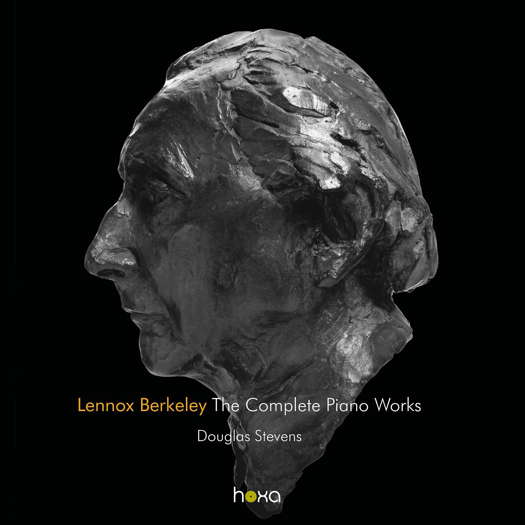- harpsichordist
- Erich Korngold
- synthesizer
- Giuditta Negri
- folk songs
- Felicity Palmer
- University of Nottingham Choir
- Douglas O'Connell
 UPDATES: There's a new feature every day at Classical Music Daily. Read about the various ways we can keep in touch with you about what's happening here.
UPDATES: There's a new feature every day at Classical Music Daily. Read about the various ways we can keep in touch with you about what's happening here.
 VIDEO PODCAST: Women Composers - Our special hour-long illustrated feature on women composers includes contributions from Diana Ambache, Gail Wein, Hilary Tann, Natalie Artemas-Polak and Victoria Bond.
VIDEO PODCAST: Women Composers - Our special hour-long illustrated feature on women composers includes contributions from Diana Ambache, Gail Wein, Hilary Tann, Natalie Artemas-Polak and Victoria Bond.

A Unique and Modern Dissonance
The complete piano music of Lennox Berkeley, heard by PATRICK MAXWELL
'... Douglas Stevens has given all of his works here a brilliant series of renditions ...'
Lennox Berkeley's music, which has never held the widespread acclaim that greeted the works of Britten and Tippett in the middle of the last century, nevertheless evokes much of the same themes which such more renowned names encapsulated. Troubled by the events of the century, there is a unique and modern dissonance lying under any more Romantic themes, but the pastoral uncertainties of an England fading into the distance are an essential presence. And still, almost more importantly, underneath much of the music there is yet an inherent playfulness and fullness of voice, which speaks mainly of his passionate inventiveness and genuistic craftsmanship.
Douglas Stevens, has, in this recording, exposed some of the more unduly neglected works of the unfairly deserted beast of English twentieth-century piano music. Although it showcases pieces from the smallest incidental sketch to the most serious sonata, much of the same qualities are in evidence throughout, as is the sparkling tendency to swerve into dissonance and unfamiliar musical territory.
The Six Preludes, Op 23, are some of the most jaunty and lively pieces on the disc, composed in 1945, around the time Berkeley left the BBC after the War.
Listen — Lennox Berkeley: Allegro (Six Preludes)
(CD1 track 4, 0:00-0:55) © 2018 Hoxa :
The first movement possesses much of this life, before the more lyrical Andante takes the listener along a characteristically wide tour of the tonal spectrum. The next movement, Allegro moderato, is among the most technically brilliant included, and uses this playfulness to full effect; melodies coincide with counter-melodies, and each form a whole which moves forward at each new bar, before fading away. One could say that this music seems transient, a brief catharsis without much base, yet with each new movement Berkeley layers gain yet another emotional veil, and there is created in each a new theme or idea which only adds vigour to the others. The fifth Prelude, Allegro, shows Berkeley again at his technical height, mixing a melodic verve with the tonal pyrotechnics which cascade through the score and ear. The next movement again makes full use of his characteristic contrasts, with a sound world which speaks of the composer's time in France, as is true of much of this early music.
The Piano Sonata, Op 20, of the same year, shows his ability to work on longer works, albeit with many of the same contrasts of vibrant virtuosity and more mysterious plaintive reflection. His harmonic structures may owe much to the French music of the first half of that century, but they are also markedly distinct; emotions are simpler, the harmonic torrents unleashed more brashly, more irresolutely. The first movement, Moderato, builds up a tension which develops through the independent voice of the right-hand melody, but yet it keeps a definite English feel, although one less secure or assured than that of Vaughan Williams or the works of Britten which came before him.
The Adagio third movement of this piece is by far the most contemplative and simple, with a Satie-like style of a repetitive bass preparing the stage for the more complex and soloistic treble line.
Listen — Lennox Berkeley: Adagio (Sonata for Piano, Op 20)
(CD1 track 12, 0:01-0:49) © 2018 Hoxa :
Berkeley possesses in this music a magisterial power of melodic control, as he puts together this effervescent piece, basking as it is in the higher stratosphere of the register. Stevens, handling some of the most challenging music in the repertoire, plays throughout with a vigorous attention to the intricate details of the pieces, although more lightness of touch in the face of the more relentless music would be desired, especially once Berkeley's more complex harmonies begin to spread even wider. The three Piano Pieces of 1935, Op 2, show the same mix of exuberance and tenderness from an earlier part of Berkeley's career, when he went to Paris under the tutelage of Nadia Boulanger and came across, and was heavily influenced by, figures such as Poulenc and Stravinsky. The second of these, the Berceuse, is one of the most enchanting and brilliant pieces performed, with a softly-spoken lyricism in the accompaniment supporting a twisting, slanting melody over the top.
Listen — Lennox Berkeley: Berceuse (Sonata for Piano, Op 20)
(CD1 track 16, 0:00-0:59) © 2018 Hoxa :
The first of the Three Impromptus from Op 7 from 1935 is also a delightfully detailed piece, with the endearing minor melody making appearances all around the keyboard, and all the different emotions contained ending swiftly, as if the previous minutes had just been a passing interlude for a greater prize. The second movement, Andantino, speaks of much the same musical world, with a sharp melody seemingly just a farcical march, with typically expressive harmonic turns attached to spruce it up and maintain its ingrained liveliness. Yet this piece, as with almost all of these pieces, goes beyond a mere sketch, and the music carries a reflective weight, very competently effected by Stevens.
Some of this music becomes darker as the years progress; the third of the Four Concert Studies of 1972, Op 24 No 1, seems forlorn and almost destitute in its eventual resolution. Stevens tells us in his excellent programme notes that the idea that Berkeley lost much of his lyricism after the 1950s should be resisted, although there is certainly less of the cantabile style to be found than in, say, the Paysage of 1944, a wonderfully developed yet almost simple piece which transports us back to the sound world of sharp contrasts between contemplation and strict verbosity.
Listen — Lennox Berkeley: Paysage
(CD2 track 20, 0:01-0:56) © 2018 Hoxa :
The Improvisation on a Theme of Manuel de Falla of 1960, Op 55, is the nearest example of any kind of return to form on show here, and its deeply contemplative tone may speak of the composer's increasingly morose turn of mind.
Listen — Lennox Berkeley: Improvisation on a Theme of Manuel de Falla
(CD2 track 26, 1:32-2:14) © 2018 Hoxa :
Even if Berkeley's legacy will continue to rest largely on his more famous compositions for orchestra and voices, these piano works deserve a recognition that can hope to improve upon that which has greeted the music of most of the composer's contemporaries in their efforts for the keyboard thus far. For Douglas Stevens has given all of his works here a brilliant series of renditions, one that shows the kind of musical dedication which is to be celebrated in the rare cases where it is achieved to greatest effect.
Listen — Lennox Berkeley: Polka Op 5 No 1 (a)
(CD2 track 27, 1:01-1:29) © 2018 Hoxa :
It requires a concentration of soulful willpower, and an unassuming integration into what can only be described as the mind of the composer himself. Many more should look on such accomplishments as this, and be glad.
Copyright © 9 November 2020
Patrick Maxwell,
Buckinghamshire, UK

CD INFORMATION: LENNOX BERKELEY COMPLETE PIANO WORKS
FURTHER INFORMATION: LENNOX BERKELEY


